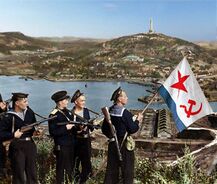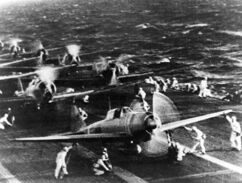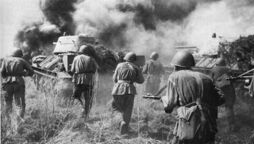Arcadian Civil War (The PU)
| Arcadian Civil War | ||||||||||
|---|---|---|---|---|---|---|---|---|---|---|
| Part of the Second Great War | ||||||||||
| ||||||||||
| ||||||||||
| Belligerents | ||||||||||
|
Democrats Secessionists |
Communists |
Loyalists | ||||||||
| Commanders and leaders | ||||||||||
|
|
|
| ||||||||
| Casualties and losses | ||||||||||
|
900,000 killed 1 million wounded, captured, or missing |
2.2 million killed 2.7 million wounded, captured, or missing |
1.4 million killed 1.3 million wounded, captured, or missing | ||||||||
|
Total Military Casualties 4.5 million killed 5 million wounded, captured, or missing Total Civilian Casualties 6.5 million killed 10 million wounded, captured, or missing Total Casualties11 million killed 15 million wounded, captured, or missing | ||||||||||
The Arcadian Civil War (12 February 1945-3 December 1950) was a multi-party civil war in the former Arcadian Empire sparked by the collapse of the absolutist imperial government during the Second Great War, as many factions vied to determine Arcadia's political future. It resulted in the formation of the two competing states; the Arcadian Free State to the west and People's Republic of Arcadia. The end of the civil war is considered the final chapter in a nearly 20-year long conflict in northern Laurentia.
While earlier scholarship pointed to June as the start of the conflict, modern historians assert that secessionist movements and groups were active in the country as early as February, with 12 February (the Aalesos Bombings) marking the start of the war. However, open conflict as its roots with the decline of the monarchy. The Arcadian monarchy ended with the abdication and suicide of Emperor Hellenos III in March 1945, and Arcadia was in a state of ongoing political flux. A tense spring led to discussions of the proper monarch, with the young son of the former emperor, Hellenos IV who was only sixteen and used as a puppet by Royal Steward Venediktos Atouis. These forces, known as Absolutists, opposed reforms, and wished to see the powerful state continue. In contrast, those who asserted that Hellenos IV's age disqualified him and an interrex was needed, meaning the crown would fall to the former emperor's brother, Pivlis II. This faction, primarily reformed-minded and backed by the Liberal Party and other pro-democracy groups came to be known as the Constitutionalists. As negotiations between the two sides declined, several regional authorities seceded from Arcadia and the country descended into a civil war. Three factions emerged, the Democrats (consisting of a coalition ranging from liberal secularists, constitutional monarchs, and anti-communist leftists), the Loyalists (consisting of forces led by Prime Minister Myron Palaiolis and Steward Georgios Radestus), and the Communists (consisting of forces led by Korexa Potami. In addition, multiple ethnic secessionist movements were present, most of whom sided with the Democrats or Communists.
Loyalist forces, primarily groups called "Imperial Hardliners" (also simply called Imperialists) took territory in the far west, in areas bordering Joseon and Libervalley where they primarily fought a guerilla war against various insurgent groups, the largest of which were the Joseonese nationalists while the more monarchially-minded Absolutists controlled areas along the southern coast around the imperial cities of Phraxos and Aalesos and the Nittilis Isles. Democratic groups controlled much of the west, especially in areas populated by lingual and ethnic minority groups, most of whom feared the Arcadian-Yawanan nationalist Loyalist groups. The Communists controlled much of the rural and agricultural east, where communism had long been scene as an alternative to the imperial system. Unofficial truces were held, with Communist and Democratic forces fighting smaller skirmishes while both concentrated against the Loyalist groups they bordered while the Absolutist and Imperialist factions of the Loyalist armies sided together against their encroaching rivals.
The first two years of war saw the defeat of the Loyalists, with the Imperialist faction primarily falling to the Democrats and the Absolutist faction falling to to the Communists. By this time, most Communist forces had fully coalesced under the People's Republic and Democratic forces had coalesced under either the fledgling Free State forces. A temporary lull in the fighting emerged as the Democratic and Communist forces attempted to negotiate a peaceful end to the war. However, the two sides were unable to come to an agreement and the fighting began again. Initially, Democratic forces saw much success, attracting many secessionist groups and pushed hard against the Communist forces. By the end of 1948, the Communist defense hinged on the city of Zaravan to the north, while Constitutionalist forces were pushing against the Communists along the coast. Democratic advances had led to a bulge in their northern lines, which was supported by Republican forces to the south.
The 1948 decision to allow the Constitutionalists, who were monarchists, into the Free State-led Democratic coalition led to a rift between the Free State-Liberal-Constitutionalist factions and the forces under the Republican Party, which was now being led by hardliner Venediktos Atouis. Atouis withdrew from the Democratic coalition and ordered his forces to attack the Free State-Liberal forces advancing on the city of Zaravan. Suddenly at risk at being cut off, the decision was made for Free State and Liberal forces to immediately retreat from Zaravan or risk encirclement. The collapse of the northern part of the advance led Democratic forces retreating as far west as Samaros, which became the focal point for the for the remainder of the war. After this, the front which was close to where the war had started stabilized, and the war became a war of attrition from 1949 to the end of 1950.
The combat ended on 3 December 1950, when the two sides agreed to a permanent armistice along the status quo, allowing combat to freeze. The cost of the war was heavy. It resulted in the destruction of virtually all of Arcadia's major cities, the deaths of 4.5 million servicemembers and 6.5 million civilian deaths, for a total of nearly 11 million. The conflict was the culmination of nearly 10 years of warfare in northern Laurentia, which, in Arcadia, had resulted in 19 million total deaths, meaning about 13.6% of all Arcadians who were alive in 1940 were dead in 1951. The two Arcadias remain divided to this day, and have fought two more conflicts between them- one in 1960 and one in 1973-1974.





